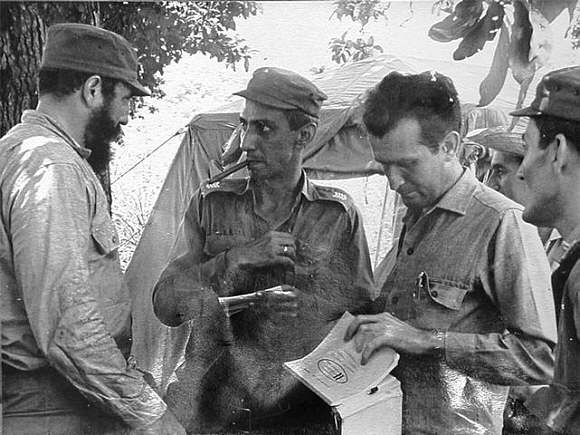|
Evolution and Socialism in Cuba
by comrade Nathan
In Miami, the enemies of the Cuban Revolution all seem
have a two-part agenda:
1) to get rid of Fidel Castro and,
2) to establish democracy in Cuba.
This is all supposed to work out very
neatly and mechanically, as if by doing the first thing (disposing of the
enemy Castro) will automatically produce the desired result (democracy).
This type of argument is called a sophism. That is to say, an idea with a
pretty, exterior wrapper but lacking any real merit inside. A worthless
present packaged inside a colorful, pricey piece of wrapping-paper.
Even
someone with the nativity of a little child couldn't possibly believe or
propose such an absurd thing. Because Cuban children do not have a hidden
agenda and a vested interest in destroying socialism in Cuba. On the other
hand, there are grown-ups in Miami who do. These adults fail to grasp the
historical patterns that have developed in Cuba over the course of many
centuries. Patterns which I am certain are instinctive to any Cuban child
born and raised on the island today.
Almost since its discovery and
colonization, Cuba has been the incubation for a long line progressive and
idealistic thinkers which helped shaped its egalitarian and communist
society today. For example, the first abolitionist to systematically
condemn slavery was Father Francisco Jose de Jaca de Aragon, in a treatise
in La Habana in 1681 titled: "A Resolution on the Freedom of Blacks
and Their Descendants". It would not have been possible for such a
thing to have occurred in another part of the New World. And even as this
document is today considered priceless in the history of human rights, it
was quickly denounced and seized by the authorities as heretic preaching.
This was almost two hundred years before the Civil War against slavery in
the United States.
The history of revolutionary thought in Cuba
demonstrate that, even without the appearance of the July 26 Movement and
the Sierra Maestra guerillas, the general recurrence of egalitarian ideas
in the last few centuries in Cuba would have eventually created an
economic model far different from what would develop in the United States.
But unfortunately, these ideas in Cuba would not have happened in a vacuum
-- like the vested interests which suppressed the liberating ideology of
Francisco Jose, the US would have intervened to corrupt the natural course
of evolution of these lofty Cuban principles.

One can detect the
historical momentum for some kind of socialist experiment beginning to
happen in Cuba by the late 19th century. You can see this character in
Jose Marti, who was anti-capitalist but not at all a Marxist. His
premature death on the battlefield was a setback, because the right person
was needed to harness the revolutionary energy of the Cubans, to put all
their energy and zeal for a better society into the right direction.
Carlos Baliño, a compatriot of Marti, entered the scene then. His
historical mission was almost like that of Father Francisco Jose in 1681.
Instead of denouncing direct slavery in Cuba, which had long since been
abolished, he was the first person to systematically denounce indirect
slavery, or capitalism, in Cuba, in his pamphlet "Socialist
Truths". Baliño was like a veritable "Johnny Appleseed" of
Cuba, instilling the most purest form of socialist ideas in the people.
And though, like Father Francisco Jose, he was not so fortunate to have
lived to see the fruit of his own selfless labor against this form of
slavery, he must have been aware that as a true Cuban, as long as Cubans
could be left to their own devices, they would naturally go in the general
direction of some kind of socialist state on their own.
The Great
Depression in the US in 1929 affected Cuba for the worse, owing to the
ever-growing North American business investments which had already been
established.
While the Great Depression in the US forced a social agenda
under FDR, in Cuba the contradictions of capitalism continued to increase.
Eventually it came to the point that Machado had to escape to Miami with a
few handguns and, it is said, five bags of gold bullion. Likewise, A
Batista fled to Daytona Beach after robbing the Cuban Treasury of not less
than $300 million. Their actions demonstrate the essential nature of
capitalism, which is akin to the modus operandi of a bank-robber, to take
the money and run. On a larger scale, it is the betrayal of the trust and
the faith which the people have invested in a government.
Yet, no matter
how many brutal dictatorships which the "Colossus of the North"
would have aided and abetted throughout the first half of the twentieth
century, the internal contradictions of state monopoly capitalism and
imperialism imposed on the island's people would have led them into
outright revolt and absolute rejection of the kind of economic system
which was developed in the USA, even if you choose not to factor in the
outstanding leadership which was to be provided by Fidel Castro and his
compatriots beginning in 1959.
Charles Darwin understood that islands tend
to produce environments in which evolution is accelerated. Which is why he
went to the Galapagos Islands to study nature and develop his theory of
evolution. Yet evolution can be forestalled and even regress itself, but
it can't completely be eliminated in nature. Especially on an island such
as Cuba.


|